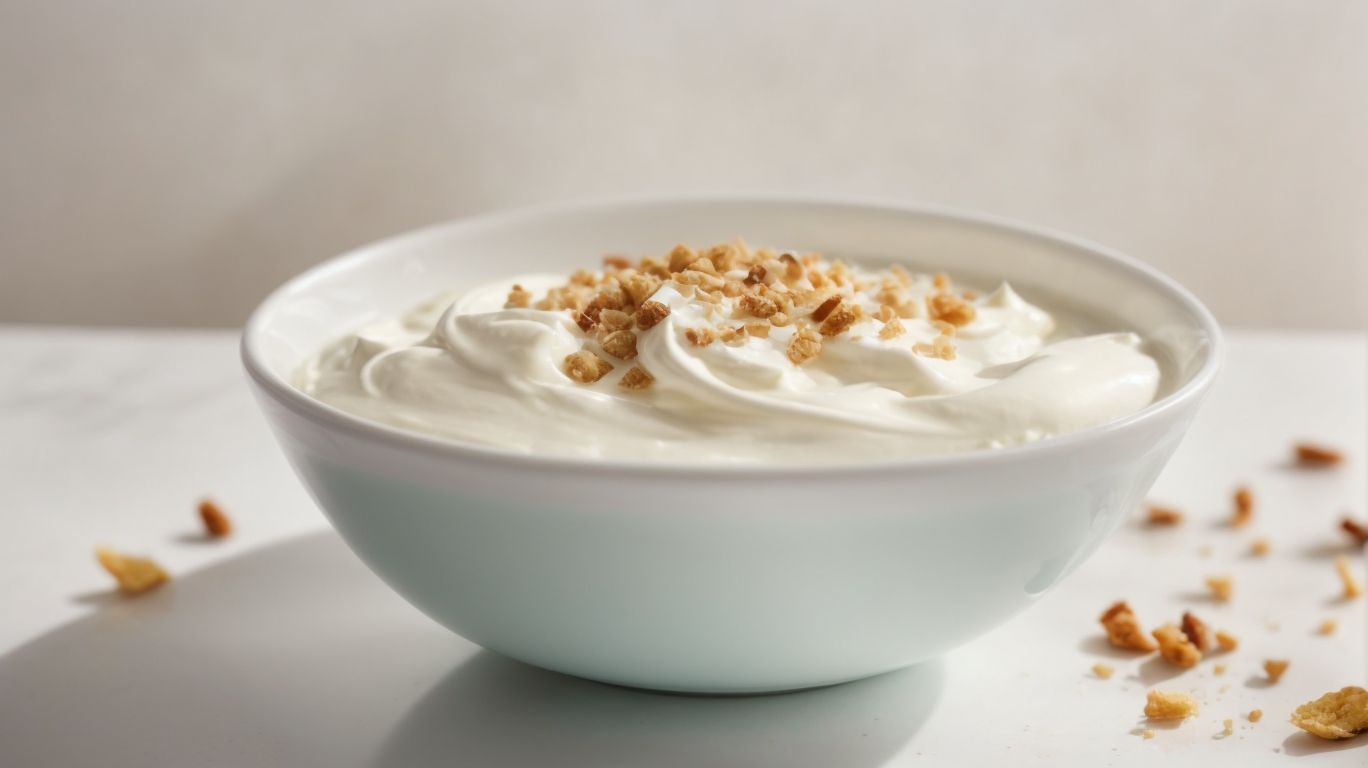How to Bake With Greek Yogurt?
Greek yogurt is a versatile ingredient that can take your baking to the next level.
Discover the benefits of using Greek yogurt in baking, such as adding moisture, boosting protein, and reducing fat.
Learn how to successfully substitute Greek yogurt in your favorite recipes and try out delicious recipes like Greek Yogurt Banana Bread and Greek Yogurt Chocolate Cake.
Elevate your baking game with the goodness of Greek yogurt!
Key Takeaways:
What is Greek Yogurt?
Greek yogurt is a thick, creamy yogurt with a strained consistency, known for its high protein content and tangy flavor.
Its luxurious texture sets it apart from regular yogurt, providing a satisfyingly rich mouthfeel. In terms of nutrition, Greek yogurt typically contains double the amount of protein compared to regular yogurt, making it an excellent choice for those looking to boost their protein intake. The tangy flavor of Greek yogurt adds a delightful zing to both savory dishes like tzatziki and sweet treats like parfaits and smoothies, showcasing its incredible versatility.
Why Use Greek Yogurt in Baking?

Credits: Poormet.Com – Gregory Perez
The incorporation of Greek yogurt in baking brings numerous benefits, enhancing moisture, adding protein, and contributing to a tender texture in various baked goods.
Adds Moisture and Tenderness
When Greek yogurt is added to baked goods, it significantly boosts moisture levels, resulting in a tender and moist texture that enhances the overall eating experience.
The addition of Greek yogurt to the batter of cakes, muffins, or breads infuses a rich, velvety consistency that is light and satisfying on the palate, making each bite a delightful experience.
This helps prevent dryness often associated with traditional recipes, creating a decadent treat that keeps you coming back for more, all while providing a healthier alternative.
Boosts Protein and Nutrients
The inclusion of Greek yogurt in baking not only adds a protein boost but also introduces essential nutrients, making the baked treats a healthier option.
One of the key advantages of incorporating Greek yogurt into baked goods is its high protein content, which helps in building and repairing tissues in the body. Greek yogurt is rich in essential nutrients such as calcium, potassium, and vitamin B12, which are crucial for overall well-being.
When used in baking, Greek yogurt provides moisture and a creamy texture to the finished products, enhancing their taste and quality. It also lends a subtle tanginess, balancing out the sweetness of desserts like cakes or muffins.
Reduces Fat and Calories
By substituting Greek yogurt for traditional fats in baking, it helps in reducing overall fat and calorie content without compromising on flavor or texture.
Greek yogurt offers additional benefits such as providing protein, calcium, and probiotics. When used in baking, it adds moisture and richness while maintaining a creamy texture. The tangy flavor of Greek yogurt can also enhance the taste of baked goods, especially in recipes like muffins, cakes, and quick breads. In addition, the high protein content helps in making the baked goods more satiating and nutritious. Incorporating Greek yogurt into your baking not only cuts down on unhealthy fat and calories but also boosts the nutritional value of your treats.
Substituting Greek Yogurt in Baked Goods

Credits: Poormet.Com – Eric Mitchell
Making substitutions with Greek yogurt in baked goods offers a simple and healthier alternative, utilizing common pantry ingredients for a versatile and flavorful result.
Substituting for Oil
Replacing oil with Greek yogurt in baking recipes not only reduces the overall fat content but also adds moisture, resulting in a moist and flavorful outcome.
By substituting oil with Greek yogurt, you are not only making a healthier choice but also transforming the texture of your baked goods. The moisture provided by Greek yogurt helps in creating a softer and richer crumb, giving your cakes, muffins, and bread both a desirable moistness and a delectable flavor.
Greek yogurt’s tangy undertones can enhance the taste profile of your baked treats, adding a unique depth that traditional oil might not provide. The final product will have a subtle complexity that elevates the overall experience for your taste buds.
Substituting for Sour Cream
Greek yogurt serves as an excellent substitute for sour cream in baked goods, offering a versatile option that maintains creaminess and tanginess.
When using Greek yogurt as a substitute for sour cream, you will find that it not only brings a similar tanginess but also adds a subtle creaminess that enhances the overall texture of your dish. Its smooth consistency blends seamlessly into recipes, making it a versatile ingredient that is ideal for both sweet and savory dishes. Whether you are making a creamy dip, a moist cake, or topping a bowl of chili, Greek yogurt can effortlessly step in for sour cream, offering a healthy twist without compromising on taste.
Substituting for Buttermilk
Greek yogurt can be used as a substitute for buttermilk in baking, providing a similar tangy flavor while enhancing the texture and moistness of the final product.
One of the key benefits of using Greek yogurt in place of buttermilk is that it adds a pleasant hint of tanginess, which can elevate the overall taste profile of your baked goods. The richness and creaminess of Greek yogurt lend a velvety texture to the final product, making it more moist and delectable. Not only does Greek yogurt act as a great texture enhancer, but it also offers a higher protein content, adding a nutritional boost. Its substitution for buttermilk opens up a world of baking possibilities, allowing for more versatility in recipes.
Tips for Baking with Greek Yogurt
When baking with Greek yogurt, it is advisable to use plain, unflavored varieties to control the sweetness and flavor profile, allowing other ingredients to shine through.
Use Plain, Unflavored Greek Yogurt
Opting for plain, unflavored Greek yogurt in baking ensures a neutral base that can adapt to various recipes, allowing the flavors of other ingredients to stand out.
Unlike flavored yogurts, which can introduce unwanted sweetness or tanginess, the subtle tanginess and creaminess of plain Greek yogurt complement a wide range of baked goods, from muffins to cakes.
Its versatility extends beyond traditional baking recipes. You can use it as a healthier substitute for sour cream or mayonnaise in savory dishes, adding richness without overpowering the dish’s overall flavor profile.
Adjust Other Ingredients
When baking with Greek yogurt, consider adjusting other ingredients such as sugar or fats to balance the flavors and achieve the desired taste profile in the final product.
For example, using Greek yogurt in place of traditional ingredients like butter or oil can result in a lighter texture and a tangy flavor. To enhance the sweetness, you might need to increase the sugar slightly, while reducing the amount of liquid to maintain the proper consistency of the batter. Experimenting with different types of sweeteners, like honey or maple syrup, can also bring a unique depth of flavor.
Adding spices such as cinnamon or nutmeg can complement the creamy richness of Greek yogurt, elevating the overall taste of your baked goods. Remember that the adjustments may vary depending on the recipe, so it’s essential to taste-test along the way and trust your palate to achieve the perfect balance of flavors.
Use Greek Yogurt in Combination with Other Ingredients
Experimenting with Greek yogurt in combination with various other ingredients can lead to innovative and versatile baked creations that cater to different tastes and preferences.
Traditional baking recipes can be elevated by substituting traditional ingredients with Greek yogurt for a healthier twist. The combination of Greek yogurt with fruits, nuts, or honey offers a unique flavor profile while keeping the texture moist and fluffy.
From cakes to muffins, the versatility of Greek yogurt allows for a wide range of culinary creations, suitable for breakfast, snacks, or indulgent desserts. The tangy creaminess of Greek yogurt complements a myriad of sweet or savory ingredients, paving the way for endless culinary adventures.
Recipes for Baking with Greek Yogurt
Explore a variety of delectable recipes for baking with Greek yogurt, including Greek Yogurt Banana Bread, Blueberry Muffins, Chocolate Cake, and Lemon Bars.
Greek Yogurt Banana Bread
Indulge in the delightful flavors of Greek Yogurt Banana Bread, a moist and flavorful treat that combines ripe bananas with the richness of Greek yogurt.
This delectable banana bread recipe offers a perfect balance of sweetness from the ripe bananas and a tangy kick from the Greek yogurt. The use of Greek yogurt not only enhances the moist texture but also adds a subtle creaminess that elevates the overall taste.
Each bite of this heavenly bread is a burst of luscious flavors, making it a versatile snack for any time of day. Whether paired with your morning coffee or enjoyed as a satisfying dessert, this banana bread is sure to impress with its irresistible moistness and rich flavor.
Greek Yogurt Blueberry Muffins
Savor the burst of juicy berries in Greek Yogurt Blueberry Muffins, a delightful recipe that combines the tangy sweetness of blueberries with the creaminess of Greek yogurt.
These tender muffins offer a perfect balance of fruity tanginess and creamy richness, making them a heavenly treat for any occasion. The Greek yogurt not only lends a moist texture but also adds a subtle tang that complements the sweetness of the plump blueberries. The recipe is simple yet yields muffins bursting with flavor. Each bite showcases the freshness of the berries and the depth of flavor from the yogurt, creating a harmonious combination that satisfies both the sweet tooth and the craving for something refreshing.
Greek Yogurt Chocolate Cake
Indulge in the decadent goodness of Greek Yogurt Chocolate Cake, a rich and moist dessert that combines the lusciousness of chocolate with the creaminess of Greek yogurt.
What sets this chocolate cake recipe apart is the unique addition of Greek yogurt, which not only enhances the moistness but also adds a subtle tanginess that balances the sweetness of the chocolate perfectly.
The incorporation of Greek yogurt not only boosts the nutritional value by providing protein and probiotics but also contributes to the cake’s velvety texture that melts in your mouth with every bite.
Whether you’re craving a decadent treat for a special occasion or simply want to elevate your baking game, this Greek Yogurt Chocolate Cake is sure to impress with its rich flavor and luxurious feel.
Greek Yogurt Lemon Bars
Delight in the zesty flavors of Greek Yogurt Lemon Bars, a tangy and refreshing dessert that harmonizes the tartness of lemons with the creamy smoothness of Greek yogurt.
This delectable treat is a perfect balance of sweet and citrusy, ideal for those who appreciate a burst of freshness in each bite. The lemon bars are characterized by a buttery, crumbly crust that perfectly complements the luscious lemon filling.
What sets these bars apart is the incorporation of Greek yogurt, which adds a rich, velvety texture and a slight tanginess that enhances the overall flavor profile. The addition of Greek yogurt also contributes to a lighter, more delicate consistency, making each bite melt in your mouth with a delightful smoothness.

